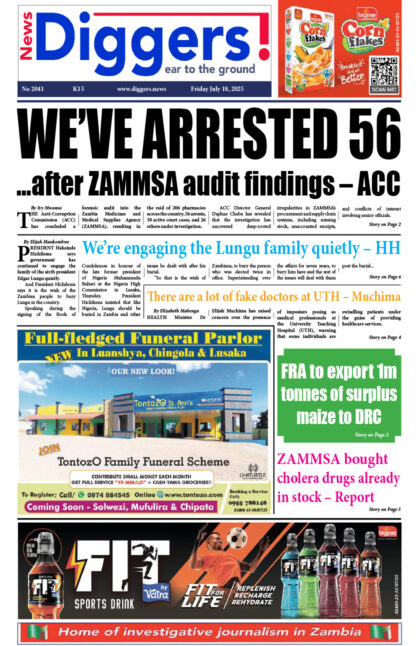In last week’s opinion piece, I noted the optimistic global growth projections fuelled by anticipated widespread use of the Covid-19 vaccine, particularly in advanced countries. Bouncing off this, I tendered a proposal on how Zambia could situate itself and seize the opportunity presented by the global growth outlook to turnaround its own growth prospects, suggesting that the Economic Recovery Programme (ERP) launched in December 2020 by the President of the Republic of Zambia, His Excellency Dr. Edgar Chagwa Lungu, be comprehensively implemented, placing a premium on employment-maximising economic activities while also making use of targeted fiscal incentives in addition to appropriate monetary policy. Specifically, this meant reinvigorating the agricultural sector and strengthening manufacturing sector capabilities, both to counter rising prices and to insulate the Zambian economy from the vagaries of the external sector.
In today’s opinion piece, I engage the ERP and burrow its details in terms of the proposals it makes for the agricultural sector and efforts to bolster manufacturing sector capabilities. I also give a critical review of these interventions in light of Zambia’s structural contradictions and emerging regional dynamics.
The ERP places great importance on the agriculture sector, stating that “In line with the 7NDP, Agriculture will continue to be a key driver of growth and job creation for the Zambian economy.” It is suggested that the “Government will continue implementing policies to enhance production and productivity in the crops, fisheries and livestock sub-sectors. The focus will be to transform the sector to promote exports by encouraging private sector participation and promotion of climate resilient agricultural practices.” The novelty of the ERP is its proposal to address the “challenges that the agriculture sector has faced including low productivity, high dependence on rain-fed agriculture, limited crop diversity and restrictions on agriculture exports. In addition, it will also address resource allocation which has not been in line with the key drivers of growth for the sector such as extension services and research and development.”
Four key measures support the ERP proposals for the agricultural sector: first, promotion of domestic and international markets; second, increased agricultural productivity; third, diversification, and fourth, Government-private sector joint action. Each of these measures is tallied with specific action required. Limited by space and scope, this opinion piece can only engage these details in limited sense. To bolster agricultural exports, a proposal to “develop a credible information system on stock position and movement for agricultural commodities by mid-2021,” has been advanced, as well as a suggestion to “enhance exports of goats, honey, wax and fish in collaboration with private sector through the establishment of trade centres at the borders with DRC and Angola, and operationalization of trade agreements.”
Meanwhile, boosting agricultural productivity will require shifting resources to key drivers of agriculture, the small holder farmers, offering them support through credit facilities, to enhance farm power and mechanisation. An array of other proposed action areas is given, which can be found in the ERP. Indeed, for the agriculture sector, the ERP must be lauded for advancing comprehensive measures and action areas which detail how to turnaround the fortunes of the sector. Nevertheless, what is not clear is the quantum of resources required to support each of these initiatives and activities and where the resources will come from within the context of high debt levels, including what agents, systems and mechanisms are in place to safeguard the resources from capture and/or rent-seeking. In addition, the ERP on agriculture is devoid of agriculture-specific monitoring and evaluation mechanisms to ensure that resources are being used efficiently and effectively. Sound implementation of proposed measures requires a systematised and institutionalised platform for monitoring and evaluating projects and programmes, ensuring that they adhere to timelines and achieve their milestones and goals.
For the manufacturing sector, the ERP notes that the sector’s contribution to GDP had grown from 7.6% in 2010 to 8.1% of GDP in 2018, though the Covid-19 pandemic has been devastating, shrinking the manufacturing sector by 4.6% in the second quarter of 2020. Aiming to expanding the manufacturing base, fiscal initiatives such as targeted tax policy will be relied upon, with three broad measures being proposed. First, targeted support to manufacturing sector and export promotion. Second, investment promotion and rural industrialisation, and finally, through the Industrial Development Corporation (IDC), establishment of various processing plants in collaboration with the private sector. If there are any critical lessons to learn from INDECO in the post-Independence era, the Government should minimise installation turnkey projects and plants, particularly in initiatives led by IDC, as these tend to minimise technology transfer, spread effects and linkages with other domestic economic activities. Being able to pick and create local winners and strengthen their competitive capacity within the context of the Africa Continental Free Trade Area (AfCFTA) and the Tripartite Free Trade Agreement will be crucial in how the manufacturing sector develops and advances.
About the Author
Dr Gabriel Pollen is a Senior Researcher (Public Finance Management) at the Centre for Trade Policy and Development (CTPD) and a Lecturer with the University of Zambia, Department of Economics.



















